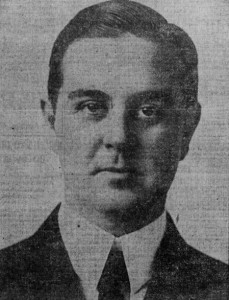Rattlesnakes for Huns: Snake Bombs of the Great War

Actor Paul Nicholson, author of the rattlesnake bomb scheme.
The great Dr Beachcombing recently wrote several posts featuring dropping things from World War I planes onto the enemy, including leaflets, poisoned candy, and hapless Belgian spies laden with hampers of carrier pigeons. Recently, while searching for something else entirely, I ran across a popular comic actor named Paul Nicholson [1875-1935], star of stage and early screen, who went the poisoned candy one better with his cunning plan to clear out the German trenches.
RATTLESNAKES FOR HUNS
Here’s Man Who Is Raising Reptiles To Drop From Airplanes
[New York Telegraph]
Paul Nicholson, who showed almost uncanny protean skill in his impersonation of Jim Corbett, Jack Barrymore, and Florence Ziegfeld in “Cohan’s Revue,” has completed the scenario of a new tragedy, which should be called “The Wrath of God, or Stinging the Hun.” Over on the sand-flat farm on Long Island, Mr. Nicholson is now assembling the cast and props of his proposed production, which, he admits and promises, is not for American production, but is to be staged somewhere in France or Germany, as it is intended, organized and will be projected wholly for a Hun audience of fighting Boches.
The cast already includes an owl, a pair of prairie dogs and two rattle snakes, the bird and the two weather hounds, however, being mere supernumeraries and used to lend atmosphere to the rehearsals and, as Mr. Nicholson says, “to make the rattlers feel at home.” The new producing manager wants more rattlesnakes, and, if all other schemes fail, he will raise as many as possible from the two large and many buttoned serpents he now holds in captivity.
“My proposed enterprise is no joking matter,” said Mr. Nicholson yesterday. “It contains the nucleus of an idea that may win the war. I am perfectly willing to share it with others, and if all the rattlesnakes in the United States can be assembled, a place will be found for them. The scheme is simple and yet far-reaching. I propose to donate all of my rattlesnakes to the aviation branch of the United States army, the deadly stingers to be dropped into the Boche trenches form the airplanes of ours and the allies’ aviators.”
“I understand that there are millions of perfectly competent rattlesnakes literally going to waste in our great West,” continued the serpentine impresario. “They are all armed with deadly weapons and ready for the war against the Huns. All they need is the chance to do their bit. They have the ammunition and the weapons. They eat very little and never drink. They require no clothing, cigarettes, comfort kits, love letters, or —
“How about parachutes?” was suggested.
“Of course, many details remained to be worked out,” said Mr. Nicholson, “But from all I can find out about ratltesnakes they are the only ready-made, sure-death, non-combustible combination of liquid fire, poison gas and barbed wire that is equal to the job of helping our armies to clean out the Hun trenches. I’m going right ahead and the day when I unloose my fanged rattlers over the Hindenburg line will be “Der Tag’ with a vengeance.
Cincinnati [OH] Enquirer 9 March 1918: p. 4
One can only imagine the process: snakes shipped in tin boxes to the War Department where they were chilled into torpor, then packed into padded, yet flimsy boxes, which would burst open on impact, releasing death by rattlesnake upon the Hun. Or perhaps men in long leather gauntlets were to scoop up handfuls of writhing rattlers and hurl them over the side of the cockpit.
The romantic in me desperately wants this to have happened sometime, somewhere over the Western Front, but the article above is the only evidence that the scheme was contemplated. The War’s end came on 11 November 1918 before any snakes could be deployed. I also note a September 1918 advertisement for a song revue in which Mr. Nicholson received star billing, titled Somewhere in France. There is probably too much of a gap between March and September to assume that the rattlesnakes were a promotional ploy for the patriotic play.
Any idea if snakes ever got off the ground during the Great War? Immobilize the head with a forked stick and deliver to Chriswoodyard8 AT gmail.com
